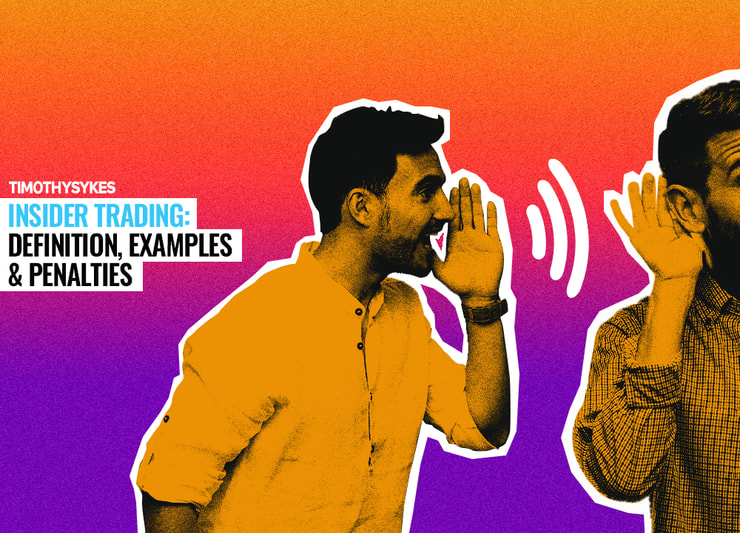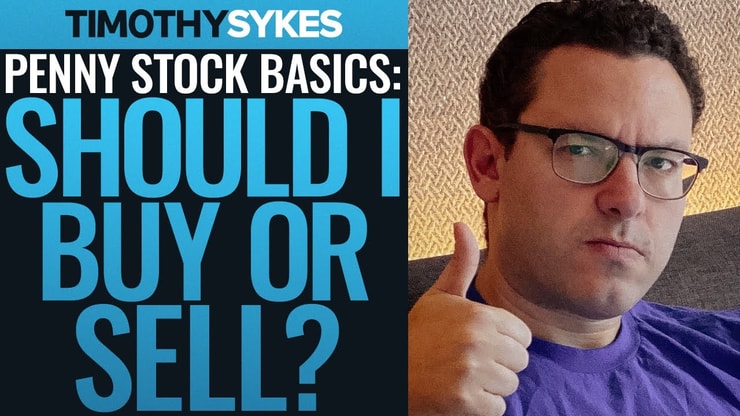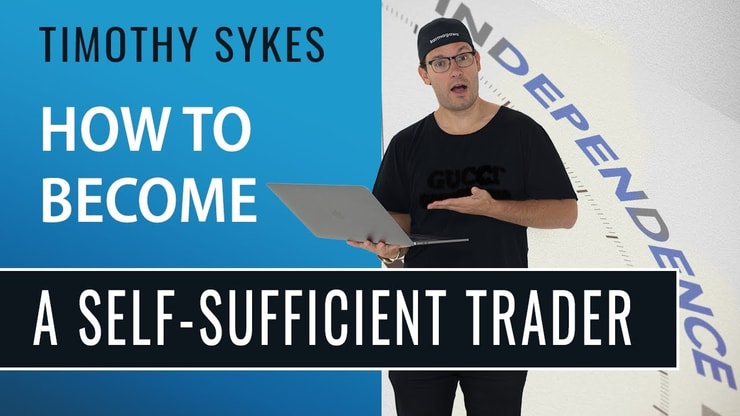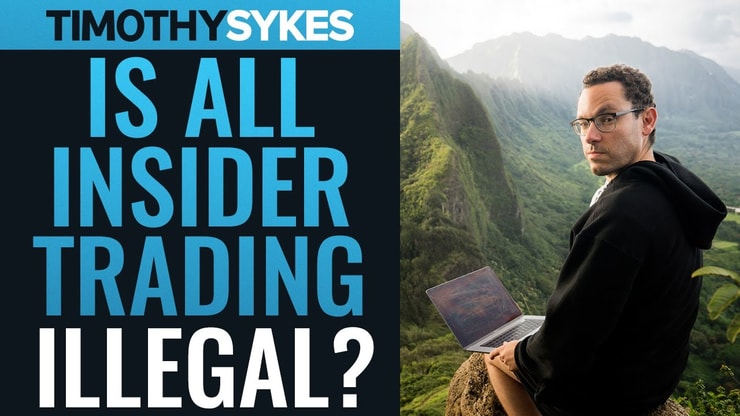The words ‘insider trading’ might conjure images of certain celebs behind bars … but do you really know what insider trading is?
For instance, did you know that not all insider trading is illegal? It depends on who’s buying and when, and how they got the information.
And actually, there’s a lot you can learn from the different types of insider trading … both legal and illegal.
In this post, I’ll break it all down: What’s insider trading? Why is it sometimes illegal? And (most fun of all) I’ll share some of the most compelling stories of illegal insider trading.
Table of Contents
What’s Insider Trading?
Insider trading is pretty much what it sounds like: making trades with the benefit of insider information.
Typically, insider trading refers to an individual or entity trading a company stock or other security based on information that isn’t readily available to the public.
Types of Insider Trading
There’s more than one type of insider trading…
In spite of the negative connotation of the phrase, insider trading isn’t always illegal. It depends on who’s doing the trading, how they got their information, and when they buy or sell.
Let’s talk a little more about both: illegal insider trading and legal insider trading.
Illegal Insider Trading
Per the U.S. Securities and Exchange Commission (aka the SEC), illegal insider trading refers to:“buying or selling a security, in breach of a fiduciary duty or other relationship of trust and confidence, while in possession of material, nonpublic information about the security. Insider trading violations may also include “tipping” such information, securities trading by the person “tipped,” and securities trading by those who misappropriate such information.”
In short, this means that if someone obtains information about a company or its stock that isn’t publicly available to get an edge in trading, it’s considered an unfair advantage. And it can be punishable by law.
Why Is Insider Trading Illegal?
As you know, I’m a big proponent of doing your own research. Doing your own research isn’t always fun. It requires a ton of effort … but it can potentially pay off for you.
But say that you do all of the necessary research on a stock before making a trade. You create a solid trading plan and make $1,000…
… and then someone else gets an insider tip that you don’t have access to. This person doesn’t have to do any research but still executes a trade and earns $100K more than you.
You’d be pretty annoyed, right? You’d think it was unfair, right?
Well, the SEC agrees. It’s not fair, and they like to try to maintain a level playing field.
Insider trading is illegal because it gives certain individuals or entities an advantage that others don’t have due to a lack of access to information.
United States Law
Insider trading has been a problem in the market for over a century.
There have been incidents of insider trading since as early as 1914 when Goodrich Rubber failed to disclose some dividend information. This prompted the New York Stock Exchange (NYSE) to begin requiring companies to issue reports relating to interest and dividends.
Then, in the 1930s, the Securities Exchange Act of 1934 was established. This put stricter rules around disclosures about company stock transactions and conflicts of interest.
It made it necessary for major stock owners to disclose their stakes in companies, as well as their personal transactions and any ownership shifts.
But it wasn’t until much later that the Insider Trading and Securities Fraud Enforcement Act of 1988 (usually just referred to as the Insider Trading Act) actually went into effect.
With it came bigger penalties and punishments for insider trading. This followed an uptick in cases involving insider trading and an escalation in the amounts being traded.
More Breaking News
- Wolfspeed Shares Skyrocket: What’s Next?
- The Rise of CHEF: Time to Consider?
- GNS Stock Rises Amid Key Market Moves and Financial Indicators
How to Avoid It
The easiest way to avoid insider trading penalties? Avoid trading stocks based on nonpublic information.
But wait … what exactly classifies as nonpublic information?
According to the SEC, this is all company information that hasn’t been disseminated to the public with ample time to react. Or as they put it:
“Generally, information which has not been available to the investing public for at least two (2) full business days is considered to be nonpublic. Recognized channels of distribution include annual reports, prospectuses, press releases, marketing materials, and publication of information in prominent financial publications, such as The Wall Street Journal.”
If the information could affect the market value or influence decisions to buy, sell, or hold, it could be considered insider information.
As for where to draw the line? Better safe than sorry. As the same document advises, “If a person feels the information is material, it probably is.”
Insider Trading Punishment
Crime doesn’t pay! There are some pretty hefty punishments associated with insider trading…
The current maximum prison sentence for insider trading is 20 years. The maximum fine is $5 million for individuals and $25 million for entities.
And it’s not like you’ll hold on to some of the extra profits. The civil penalty for a violator could be an amount up to three times the profit gained or loss avoided as a result of the insider trading violation.
How Insider Trading Is Investigated and Prosecuted
Insider trading can be tough to prove, so there isn’t just one way that it’s monitored. Here are some key ways the SEC keeps tabs on potential insider trading activities:
- Surveillance: Feel like someone’s watching you? They might be if you’ve been up to no good in the stock market. The SEC has plenty of tools to help them sniff out illegal insider trading, and they get very curious when someone makes huge profits around the same time as big company news or earnings reports.
- Tip-offs: Whistleblowers are a thing. Plenty of insider trading is tipped off to government agencies from other insiders or traders who get jilted by the insider trade. The SEC gets a ton of calls about potential insider trading. While not all of them will turn into criminal cases, plenty of insider trading cases have started this way.
- Other sources: Insider trading leads can come from other sources as FINRA, media reports, and so on.
Trading Challenge
One of the best ways to avoid potential fines? Learn to think for yourself and make your own trading decisions. Educate yourself on how to conduct yourself properly in the market.
In my Trading Challenge, I emphasize doing your own research rather than following hot stock tips or listening to ANYTHING anyone else tells you. Not only is this a good way to be self-sufficient, but it could keep you from getting into hot water!
In my Trading Challenge, I’m looking to help emerging traders by teaching them the things I’ve learned in my 20+ years in the stock market.
I’ve created video lessons, webinars, and an active chat room community to help support your studies … I want to teach you how to work the market the right way so that you can work toward a long-term, sustainable trading career.
Interested? Consider advancing your trading career … apply for my Trading Challenge today!
Illegal Insider Trading Examples
It’s that time! We all love a good story … so let’s talk about some of the most legendary insider trading cases…
Ivan Boesky
Did you know that Ivan Boesky is reportedly the inspiration behind the legendary Gordon Gekko character from the movie “Wall Street?”
Boesky’s specialty was corporate takeovers: he’d profit from investing based on new partnerships or acquisitions. He did well: by the mid-1980s, he was reportedly worth over $200 million.
Unfortunately, the “greed is good” mentality didn’t serve him well in the long run. In 1987, he was sued over what partners claimed to be misleading documents about partnerships. Soon after, the SEC launched an investigation about information he’d received from corporate officers.
He had several big stock buy-ins just days before corporations announced takeovers. At the time, crimes like this weren’t extremely enforced. But this one was a big one, and Boesky informed on others to reduce his prison sentence.
Even so, he was fined $100 million and sentenced to three and a half years in prison. Remember, crime doesn’t pay!
Albert Wiggin
Once upon a time, Albert Wiggin was the highly respected head of Chase Bank. But then, right before the 1929 stock market crash, it was revealed that he’d shorted 40,000 shares of his own company stock. Conflict of interest? Yes indeed.
Adding insult to injury, he used family-owned corporations to hide his trades and worked from behind the scenes to build a position that would benefit him if the company failed.
Believe it or not, at the time there wasn’t a law against shorting your own company … so Wiggin actually made $4 million in 1929 from his own company’s downfall and went on to take a big ol’ pension.
However, public outcry was strong, so the pension was ultimately declined. The Wiggins debacle is seen as a direct forerunner to the Securities Exchange Act of 1934, which made the rules about insider trading much more strict. Its nickname? The “Wiggin Act.”
Martha Stewart
Here’s proof that directors and CEOs aren’t the only ones who can be convicted of insider trading.
In 2003, the undisputed queen of homemaking was charged with obstruction of justice and securities fraud for selling shares of a stock early to save a big loss based on insider information.
The charges were based on an event in 2001. During that year, ImClone, a biopharmaceutical company, had a drug that failed in the FDA. This caused the shares to fall 16% in one day.
However, before the drop, Stewart sold about 4,000 shares based on a tip from a broker at Merrill Lynch following the company’s CEO selling all of his shares of the company.
Stewart did indeed save about $45K, but her trade was based on information that wasn’t available to the public.
Stewart was eventually charged and ended up serving five months in a federal corrections facility.
R. Foster Winans
Talk about journalistic integrity … or lack thereof.
In the 1980s, R. Foster Winans worked for the Wall Street Journal writing a column called “Heard on the Street,” where he profiled stock picks.
Often, his influence would affect a stock … The public would often buy or sell based on his opinions.
Unfortunately, he used that influence for some shady dealings…
In 1985, he was convicted of insider trading and mail fraud. As it turns out, he’d leaked the contents of his column to a stockbroker, and taken a kickback of the proceeds. He went on to serve about nine months in a federal facility.
Reliance Industries
Reliance Industries is a conglomerate company with headquarters in Mumbai. They’ve been under SEBI’s (The Securities and Exchange Board of India) scrutiny several times.
In 2007, directors at Reliance got approval to sell part of their stake in Reliance Petroleum. Then, later in the year, several parties connected to Reliance began to take short positions in Reliance Petroleum.
Soon after, Reliance began selling the approved stake. Then, they placed a series of large orders below the market rate, leading stock prices to fall. This led to what some consider unlawful gains from the related entities.
SEBI contended that the entities had traded on behalf of Reliance and that the profits were ultimately transferred to the company and accounted for as “other income.”
By doing this, Reliance made some huge gains. But things didn’t move fast.
It wasn’t until a decade later that SEBI passed an order forcing Reliance to give up some of the unlawful gains and had them pay back interest since 2007.
Joseph Nacchio
Talk about a fall from grace. Joseph Nacchio was once the CEO and chairman of the board at Qwest … pretty sweet gig.
But in 2005, he and other former Quest execs were sued by the SEC after being accused of $3 billion worth of financial fraud.
The SEC stated that Nacchio made unrealistic claims that Qwest would be able to meet revenue targets even though he knew they were highly unlikely. This helped them gain the ability to acquire another rival, among other things.
But then … he sold $100 million worth of his own Qwest stock. A funny thing for someone to do when they were making such amazing claims.
Though Nacchio argued that he truly believed that the company would be benefitting from big government contracts and was doing well, the judge disagreed.
He was indicted in 2005 on 42 counts of insider trading charges … and found guilty on 19 of them.
In 2007 he was sentenced to six years in federal prison. He also received a $19 million fine and had to give up the $52 million he got from the illegal stock sales.
Yoshiaki Murakami
Then there’s this Japanese financier and former head of the Murakami Fund and self-proclaimed corporate raider. He became famous for loading up on shares in corporations and then forcing them to increase value for shareholders.
However, in 2006 he was arrested for suspected insider trading.
The story? He bought a ton of shares of NBS after he got advance intel of a potential takeover.
Murakami bought over $80 million worth of NBS shares, driving up the price and giving him a big profit, even though the takeover didn’t happen.
He pleaded not guilty, but the powers that be disagreed. In 2007, he was given two years in jail.
Raj Rajaratnam
In 2011, billionaire hedge-fund manager Raj Rajaratnam was sentenced to 11 years in prison for insider trading — one of the stiffest sentences to date.
According to the SEC, he created and pulled the strings behind a massive insider trader ring including 29 individuals and entities. The insiders ranged from corporate insiders to hedge-fund advisers to Goldman Sachs board members to other Wall Streeters.
Rajaratnam was said to be involved in the insider trading of more than 15 public companies and responsible for over $90 million in avoided losses or illegal profits.
In a lawsuit brought by the SEC, Rajaratnam was ordered to pay $93 million in penalties, $10 million in fines, and to forfeit $54 million … in addition to the prison sentence.
Legal Insider Trading
While “insider trading” might instantly bring up red flags and visions of execs being carted off in handcuffs, it’s not always illegal. Legal insider trading happens all the time in the stock market … no arrest montage included.
First, let’s talk about what “insider” actually means. An insider is considered a senior staff member of a company or someone who owns a significant amount of voting shares with the company.
Insiders are in fact allowed to trade shares of the stock. However, they have to adhere to pretty strict policies about how they buy and sell the shares, and there are disclosure requirements in place.
The SEC requires that insiders submit their transactions and that they disclose them on the company website.
If the company insider buys or sells shares but sticks with the stipulations put forth by the SEC and fills out the required forms, it’s not illegal.
In fact, sometimes I even look for insider trading information to help choose trades … For example, if a CEO loads up on shares, that could be a potential sign of company strength.
What’s a Trading Window
A trading window is a period in which a company lets its executives and employees trade its stock. A window period usually occurs quarterly, a few days after the company releases its quarterly earnings.
The window typically remains open for four to six weeks. The opposite of a trading window is a blackout period. That’s when no execs or employees can trade the stock.
Arguments for Legalizing Insider Trading
You know what? Not everyone thinks that insider trading should be illegal. Why? Here are a few common reasons…
For one, what can be considered insider trading often exists in a grey area. How does one define the difference between proprietary information and insider information?
How does it differ from simply being the early bird and being on the receiving end of inside intel? Well, there’s not always an easy answer to that. This can make it tough to determine when there’s wrongdoing at hand.
For another, in spite of what movies and TV would have you believe, insider trading doesn’t always guarantee a massively profitable outcome. Even though a stock might go up or down based on the information, it’s never a sure thing.
One more reason? Some argue that the enforcement of insider trading is “selective” at best and that makes it unfair. What do you think?
Countries Where Insider Trading Is Legal
Most, if not all countries now have some kind of law or recommendations against insider trading.
However, they all have varying degrees of penalties and enforcement.
Legal Insider Trading Examples
Curious about what might constitute a legal insider trade? Here are some examples:
- A company CEO buys 5,000 shares of stock in the corporation and reports it in a timely manner to the SEC, filling out the necessary paperwork and adhering to SEC guidelines for disclosure.
- A company employee takes advantage of stock options, loading up on shares of the company that they work for.
- A board member sells 100 shares of stock and fills out the necessary paperwork and disclosures.
Boring, right? Maybe it’s not as exciting as the stories in this post about illegal insider trading, but that’s a good thing. When it comes to the law, sticking with boring but legal is good!
Frequently Asked Questions About Insider Trading
How Long Has Insider Trading Been Illegal?
In the U.S., insider trading has been illegal since the Securities Exchange Act of 1934. By the 60s or 70s, most countries had laws in place prohibiting insider trading. The EU countries lagged behind the rest of the world and finally made insider trading illegal in 1989.
How Is Insider Trading Proven?
Insider trading can be difficult to prove since evidence is usually circumstantial. The SEC tracks insider trading through market surveillance, tips, and whistleblowers.
What’s a Blackout Period for Stocks?
A blackout period is a set time frame when insiders aren’t allowed to trade their company’s stock. Insiders are restricted to trading only during a trading window unless they complete the required disclosures with the SEC.
Are Politicians Exempt From Insider Trading?
The STOCK Act was signed into law in 2012, prohibiting members of Congress and other government employees from profiting on knowledge gained during the course of their job. They’re held to the same laws regarding insider trading, but it can still be difficult to prove.
Conclusion
Insider trading is more complicated than most people realize. Sure, there’s a reason why there are negative connotations associated with it. Particularly when high-ranking insiders abuse their power and knowledge to get an edge over other traders.
However, not all insider trading is the same, and not all insider trading is illegal. In fact, the legal kind can actually tip you off to legit and legal potential trades.
There’s no need to be fraudulent in your trading. There are enough opportunities that you can keep things on the level and stay safe in your career.
What was most interesting for you to learn about insider trading here? Leave a comment and let me know!









Leave a reply